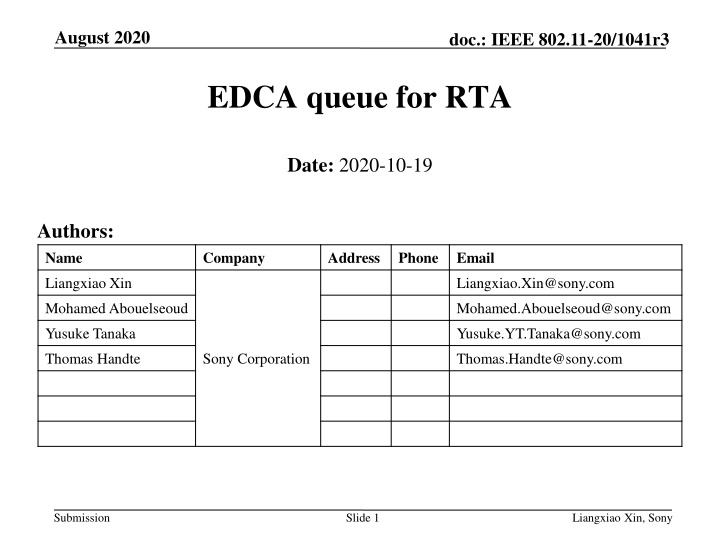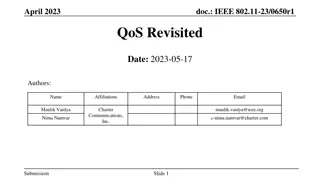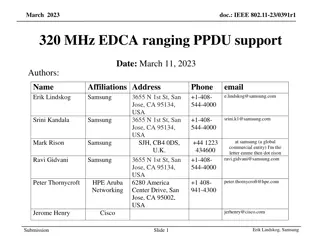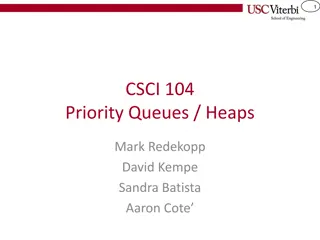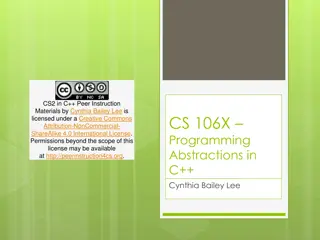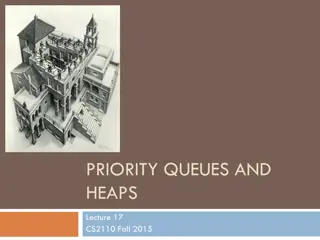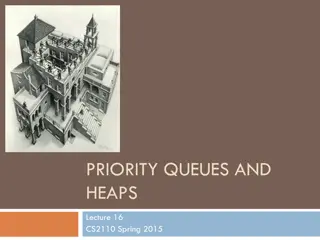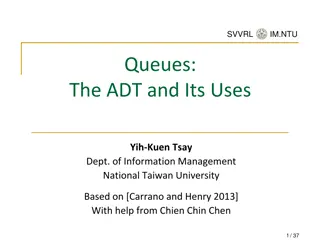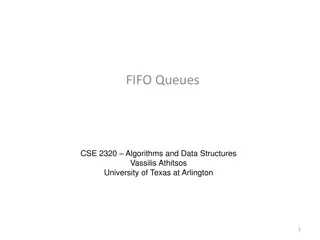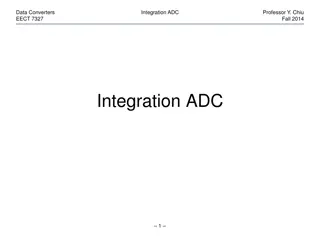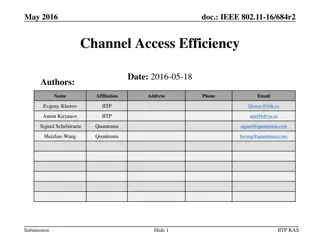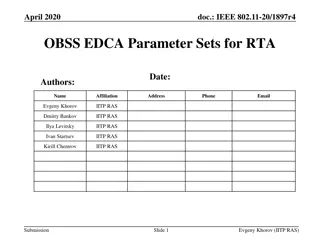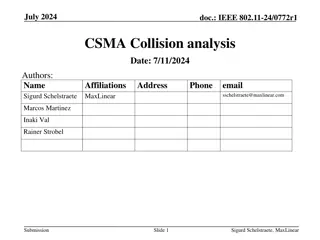Solutions for Enhancing EDCA Queues in IEEE 802.11 Networks
Discussing proposed solutions to update the queue system for Real-Time Applications (RTA) traffic in IEEE 802.11-20/1041r3 to meet latency requirements. Solutions include prioritizing RTA traffic, differentiating RTA from non-RTA traffic, and managing transmit queues effectively.
Download Presentation

Please find below an Image/Link to download the presentation.
The content on the website is provided AS IS for your information and personal use only. It may not be sold, licensed, or shared on other websites without obtaining consent from the author.If you encounter any issues during the download, it is possible that the publisher has removed the file from their server.
You are allowed to download the files provided on this website for personal or commercial use, subject to the condition that they are used lawfully. All files are the property of their respective owners.
The content on the website is provided AS IS for your information and personal use only. It may not be sold, licensed, or shared on other websites without obtaining consent from the author.
E N D
Presentation Transcript
August 2020 doc.: IEEE 802.11-20/1041r3 EDCA queue for RTA Date: 2020-10-19 Authors: Name Company Address Phone Email Liangxiao Xin Liangxiao.Xin@sony.com Mohamed Abouelseoud Mohamed.Abouelseoud@sony.com Yusuke Tanaka Yusuke.YT.Tanaka@sony.com Thomas Handte Sony Corporation Thomas.Handte@sony.com Submission Slide 1 Liangxiao Xin, Sony
August 2020 doc.: IEEE 802.11-20/1041r3 Introduction A lot of contributions have suggested, or proposed solutions include updating the queue system to satisfy the latency requirement for RTA traffic [1-10]. In this presentation, we discuss several solutions to enhance EDCA queues for RTA traffic. Submission Slide 2 Liangxiao Xin, Sony
August 2020 doc.: IEEE 802.11-20/1041r3 Motivation EDCA queue maps user priority as defined in 802.1D to the transmit queues. The VI and VO traffic types are already characterized as low latency traffic in 802.1D VI: < 100ms latency and jitter, VO: <10ms latency and jitter However, EDCA queue does not prioritize the delivery of RTA MSDUs within the bounded latency and jitter Non-RTA MSDUs do not have bounded latency requirement RTA MSDUs have different bounded latency requirements We discuss options to manage the RTA MSDUs for VI or VO traffic in the EDCA queues Differentiate RTA traffic from VI or VO traffic Prioritize the transmission of RTA traffic to meet its bounded latency requirement Submission Slide 3 Liangxiao Xin, Sony
August 2020 doc.: IEEE 802.11-20/1041r3 Proposed solution 1 EDCA queue management: differentiate the RTA traffic and non-RTA traffic and prioritize the RTA traffic in an existing queue Reorder the MSDUs in the transmit queue based on the expiration time of bounded latency. Then, the MSDU with shorter expiration time could be transmitted earlier in the transmit queue with higher probability. The bounded latency of non-RTA traffic could be EDCA lifetime or infinity. Limitation: RTA MSDUs and non-RTA MSDUs share the same transmit queue. It requires heavy processing to manage dynamic changes in the queue It is possible that the queue buffer is fully occupied by non-RTA MSDUs and RTA MSDUs cannot be enqueued. Examples of other ideas for EDCA queue management DCN0468r0 [1]: use a new UP for a high priority service DCN0418r4 [9]: use TIDs 8~15 to classify traffic streams with different QoS requirement DCN1045r3 [10]: use L-Marker to classify traffic streams per (source/destination, TID) Submission Slide 4 Liangxiao Xin, Sony
August 2020 doc.: IEEE 802.11-20/1041r3 Proposed solution 2 Add new transmit queues to the existing EDCA queue system R_VI transmit queue Enqueue RTA VI traffic (RTA traffic with UP 5) Has higher priority than A_VI & VI transmit queues R_VO transmit queue Enqueue RTA VO traffic (RTA traffic with UP 6) Has higher priority than VO transmit queue Has lower priority than A_VO transmit queue Proposed solution 1 can be applied to the new transmit queue. Need to consider the fairness between RTA queue and non-RTA queue DCN1175r0 [2]: limit the size and frequency of frames enqueued to RTA queue Limitation: new transmit queue shares the same EDCA parameters with old ones. (MSDU, UP, RTA) Mapping to transmit queues and AC A_VI R_VI VI VO R_VO A_VO BE BK Transmit queues EDCA functions with internal collision avoidance VO BE BK VI Channel Submission Slide 5 Liangxiao Xin, Sony
August 2020 doc.: IEEE 802.11-20/1041r3 Proposed solution 3 Add new EDCAF (i.e., AC) to the existing EDCA queue system LL EDCAF with R_VO transmit queue Enqueue RTA traffic (with UP 6) to R_VO transmit queue Possible techniques can be added onto the new AC DCN1851r0 [3] & DCN1524r0 [4] : Operation of EDCAF parameters DCN1287r1 [5] : Time-Aware Shaping (802.1Qbv) over Wireless DCN1960r1 [11] : Early channel contention Limitation: Should update internal collision mechanism (MSDU, UP, RTA) Mapping to transmit queues and AC R_VO VO A_VO BE A_VI VI BK Transmit queues EDCA functions with internal collision avoidance LL VO VI BE BK Channel Submission Slide 6 Liangxiao Xin, Sony
August 2020 doc.: IEEE 802.11-20/1041r3 Summary In this presentation, we propose to differentiate RTA traffic from non- RTA traffic and prioritize the transmission of RTA traffic. Multiple solutions to provide low latency service in the existing EDCA queue systems are proposed: Proposal 1: Add new features to the existing EDCA queue system only Proposal 2: Add new transmit queues for RTA traffic Proposal 3: Add new EDCAF/AC for RTA traffic Submission Slide 7 Liangxiao Xin, Sony
August 2020 doc.: IEEE 802.11-20/1041r3 SP1 Do you support to include the following in SFD? 11be shall define a mechanism that differentiates low latency traffic from regular traffic and prioritizes the transmission of low latency traffic in R1. 42Y/9N/27A Submission Slide 8 Liangxiao Xin, Sony
August 2020 doc.: IEEE 802.11-20/1041r3 SP2 Which option do you support to enhance EDCA queue for low latency traffic? Option 1: EDCA queue management Option 2: new transmit queues for current EDCAF Option 3: a new low latency EDCAF Something else Abstain Submission Slide 9 Liangxiao Xin, Sony
August 2020 doc.: IEEE 802.11-20/1041r3 References [1] 11-20/0468r0: Channel Access Category [2] 11-19/1175r0: Considerations of New Queue Mechanism for Real-Time Application [3] 11-19/1851r0: Latency enhancement in multi-link [4] 11-19/1524r0: Latency enhancement for EHT [5] 11-19/1287r1: TSN support in 802.11 and potential extensions for Tgbe [6] 11-19/1933r1: Capabilities to support Time-Aware Scheduling in 802.11be [7] 11-19/1780r0: AR/VR on EHT: Design Considerations [8] 11-20/0005r1: Proposals on Latency Reduction [9] 11-20/0418r4: Low latency service in 802.11be [10] 11-20/1045r3: Prioritized EDCA channel access [11] 11-19/1960r1: Reducing Channel Access Delay for RTA Traffic Submission Slide 10 Liangxiao Xin, Sony
